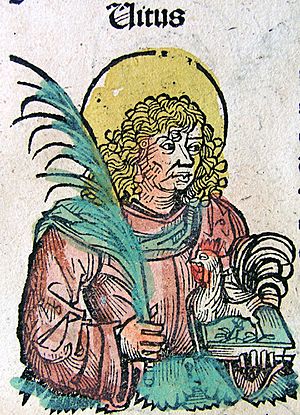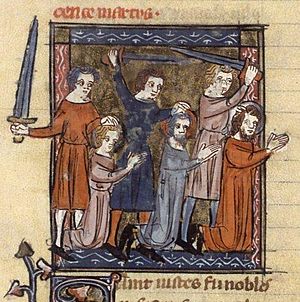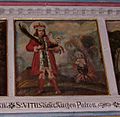Saint Vitus facts for kids
Quick facts for kids SaintVitus |
|
|---|---|

Saint Vitus, from the Nuremberg Chronicle, 1493
|
|
| Martyr, Holy Helper | |
| Born | c. 290 Mazzara del Vallo, Sicily |
| Died | c. 303 (age 12–13) Lucania, modern-day Basilicata, Italy |
| Venerated in | Roman Catholic Church Eastern Orthodox Church |
| Feast | 15 June |
| Attributes | depicted in a cauldron, with a rooster or a lion |
| Patronage | actors; comedians; Rijeka, Croatia; Czechoslovakia; dancers; dogs; epilepsy; Mazara del Vallo, Sicily; Forio, Ischia; oversleeping; Prague, Czech Republic; rheumatic chorea (Saint Vitus Dance); Serbia; snake bites; storms; Vacha, Germany; Zeven, Lower Saxony; the Gooi, Netherlands; E Clampus Vitus |
Saint Vitus (sometimes called Guy or Guido) was an early Christian saint from Sicily. His life story is mostly a legend, meaning we don't have many true historical facts about him. He is often linked with two other figures, Modestus and Crescentia, but they were likely added to his story later.
According to his legend, Vitus died around the year 303 AD. This was during a time called the Diocletianic Persecution, when Christians were punished for their faith. In the Middle Ages, he became known as one of the Fourteen Holy Helpers. This was a group of saints believed to help people in times of trouble.
In Germany, people used to dance in front of his statue on his feast day. This dancing became so popular that a movement disorder, which causes jerky, uncontrolled movements, was named "Saint Vitus Dance." Because of this, Vitus is seen as the patron saint of dancers and entertainers. People also believe he protects against lightning, animal attacks, and oversleeping. His special day is June 15th.
The Legend of Saint Vitus
The most famous story about Vitus says he was a young boy, possibly 7 or 12 years old. He lived in Lucania, a region in southern Italy. His father, a senator, tried to make him give up his Christian faith. Vitus refused, even when he faced difficult challenges.
He ran away with his tutor, Modestus, and Modestus's wife, Crescentia, who was also Vitus's nanny. They went to Lucania. Later, Vitus was taken to Rome. The story says he helped the Roman Emperor Diocletian's son by driving out a demon.
Even after this, Vitus remained faithful to Christianity. Because of his beliefs, he and his tutors faced harsh trials. The legend says an angel miraculously brought them back to Lucania. There, they eventually died from the suffering they had endured. Three days later, a kind woman named Florentia found their bodies and buried them.
Why Saint Vitus is Honored

People in Southern Italy and Sicily started honoring Saint Vitus very early on. Pope Gregory the Great mentioned a monastery in Sicily dedicated to him. In Rome, a chapel was also named after him in the 7th century.
In 756 AD, some of Saint Vitus's relics (holy remains) were brought to France. Later, in 836 AD, some were moved to Corvey in Germany. From there, his popularity grew across Germany.
His veneration became very important in Prague, Bohemia. In 925 AD, King Henry I of Germany gave a bone from Saint Vitus's hand to Duke Wenceslaus. This relic became a sacred treasure in St. Vitus Cathedral in Prague. More relics were brought to Prague in 1355 by Emperor Charles IV.
Saint Vitus is very popular in Slavic countries. His feast day, called Vidovdan in Serbia, is especially important. Many historical events in Serbia are linked to this day. In Croatia, 123 churches are dedicated to him.
Vitus is one of the Fourteen Martyrs who are believed to help people in trouble. He is specifically asked for help with Sydenham's chorea, which is known as St. Vitus Dance.
He is often shown as a young man holding a palm leaf. Sometimes he is pictured in a cauldron with a rooster or a lion. This is because, according to the legend, he was thrown into a boiling pot of tar and molten lead but miraculously survived without harm.
The names of Saints Modestus and Crescentia were added to the Roman Calendar in the 11th century. This meant all three were celebrated together. However, in 1969, their feast day was removed from the main calendar. Vitus is still recognized as a saint by the Catholic Church. His feast day is June 15th. Modestus and Crescentia are no longer officially celebrated because they are believed to be fictional characters.
Saint Vitus is the patron saint of many places. These include the city of Rijeka in Croatia, the towns of Ciminna and Vita in Sicily, and the Gooi region in the Netherlands. Many places in Austria and Bavaria are named Sankt Veit in his honor.
There's a popular weather rhyme about his feast day: "If St. Vitus' Day be rainy weather, it shall rain for thirty days together."
Images for kids
-
Martyrdom of Saint Vitus, Germany circa 1515, St. Vitus church, Flein
-
An image of Saint Vitus in Heiligenstadt, Franconia
-
Martyrdom of Saint Vitus/Sankt Veit on the coat of arms of Sankt Veit im Pongau, Austria
-
Gothic Revival high altar (1911) at the Saint Vitus Parish Church in Pfarrkirchen im Mühlkreis, Upper Austria, by Ludwig Linzinger
-
Church of Saint Vitus, Libědice, Czech Republic
-
Church of Saint Vitus, Blaricum, Netherlands
-
Church of Saint Vitus, Treffelhausen, Baden-Württemberg, Germany
See also
 In Spanish: Vito de Lucania para niños
In Spanish: Vito de Lucania para niños
- List of early Christian saints
- Saint Vitus, patron saint archive
- Statue of Vitus, Charles Bridge











